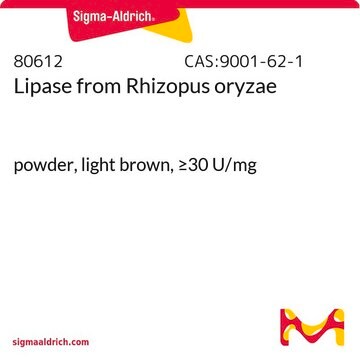N5661
Nuclease S1 from Aspergillus oryzae
for single-strand DNA/RNA digestion
Synonym(s):
Endonuclease S1
Select a Size
Select a Size
About This Item
Recommended Products
biological source
Aspergillus sp. (A. oryzae)
Quality Level
form
solution
concentration
≥100000 units/mL
technique(s)
DNA purification: suitable
suitability
suitable for nucleic acid purification
application(s)
cell analysis
shipped in
wet ice
storage temp.
−20°C
Looking for similar products? Visit Product Comparison Guide
Related Categories
General description
Application
Biochem/physiol Actions
Unit Definition
Physical form
Kit Components Only
- 30mM Sodium acetate .25-.25 %
- 50mM Sodium chloride .29 %
- 1mM Zinc chloride .01 %
- Glycerol 50 %
- 2mg/mL Protein .2 %
Storage Class Code
10 - Combustible liquids
WGK
WGK 2
Flash Point(F)
Not applicable
Flash Point(C)
Not applicable
Choose from one of the most recent versions:
Certificates of Analysis (COA)
Don't see the Right Version?
If you require a particular version, you can look up a specific certificate by the Lot or Batch number.
Already Own This Product?
Find documentation for the products that you have recently purchased in the Document Library.
Customers Also Viewed
Protocols
Spectrophotometric assay at 260 nm measures nuclease S1 activity, vital for nucleic acid research, with defined enzyme unit criteria.
Our team of scientists has experience in all areas of research including Life Science, Material Science, Chemical Synthesis, Chromatography, Analytical and many others.
Contact Technical Service










